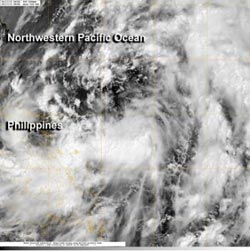NASA satellite sees developing tropical depression near Philippines

System 91W appears ripe to become Tropical Depression 4 in the next couple of days as it continues moving north and parallels the east coast of the Philippines. NASA's Aqua satellite captured a visible image of the developing low pressure area as it passed overhead in space on June 17.<br><br>Credit: NASA<br>
On June 16 at 2200 UTC (6 p.m. EDT) System 91W was located near 13.5N and 126.9E, about 355 miles east-southeast of Manila, Philippines.
NASA's Aqua satellite passed over System 91W on June 17 at 05:08 UTC (1:08 a.m. EDT) and the Moderate Resolution Imaging Spectroradiometer (MODIS) instrument aboard captured a visible image of the consolidating storm.
Satellite imagery showed strong bands of thunderstorms over the northern and southern quadrants of the storm. The low-level center of circulation appears to be consolidating, and the banding of thunderstorms around it have improved in the last day.
According to the Joint Typhoon Warning Center, System 91W has a high chance of becoming Tropical Depression 4 in the next day or two. Computer models indicate that it will continue tracking northward and parallel the coast of the Philippines over the next couple of days and residents along the coast can expect rough seas, gusty winds and rain as the low pressure area moves north.
Media Contact
More Information:
http://www.nasa.govAll latest news from the category: Earth Sciences
Earth Sciences (also referred to as Geosciences), which deals with basic issues surrounding our planet, plays a vital role in the area of energy and raw materials supply.
Earth Sciences comprises subjects such as geology, geography, geological informatics, paleontology, mineralogy, petrography, crystallography, geophysics, geodesy, glaciology, cartography, photogrammetry, meteorology and seismology, early-warning systems, earthquake research and polar research.
Newest articles

Superradiant atoms could push the boundaries of how precisely time can be measured
Superradiant atoms can help us measure time more precisely than ever. In a new study, researchers from the University of Copenhagen present a new method for measuring the time interval,…

Ion thermoelectric conversion devices for near room temperature
The electrode sheet of the thermoelectric device consists of ionic hydrogel, which is sandwiched between the electrodes to form, and the Prussian blue on the electrode undergoes a redox reaction…

Zap Energy achieves 37-million-degree temperatures in a compact device
New publication reports record electron temperatures for a small-scale, sheared-flow-stabilized Z-pinch fusion device. In the nine decades since humans first produced fusion reactions, only a few fusion technologies have demonstrated…





















